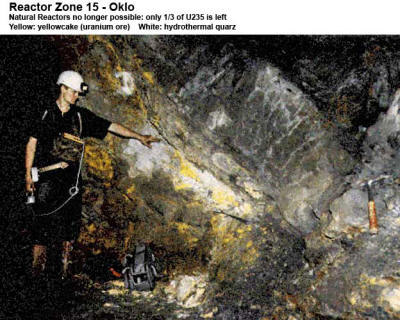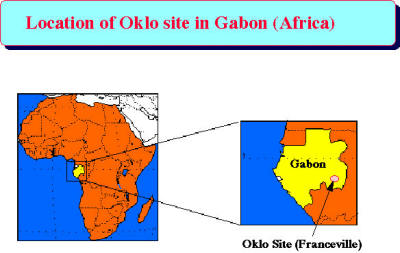|
April, 2003 from PureInsight Website
Oklo - Ancient African Nuclear Reactor
The remnants of nuclear reactors nearly two billion years old were found in the 1970s in Africa.
These reactors are thought to have occurred naturally. No natural reactors exist today, since the relative density of fissile uranium has now decayed below that needed for a sustainable reaction. Pictured above is Fossil Reactor 15, located in Oklo, Gabon.
Uranium oxide remains are visible as the yellowish rock. Oklo by-products are being used today to study the stability of the fundamental constants over cosmological time-scales and to develop more effective means for disposing of human-manufactured nuclear waste.
In 1972, a French company imported some uranium ore from Oklo in the Gabon Republic in Africa. Surprisingly the uranium concentration in the ore was as low as spent uranium fuel from a nuclear reactor.
The finding led scientists to believe that the uranium had already been used for energy production. This discovery shocked the world and attracted scientists from many countries to go to Oklo for further investigation.
The results showed that the uranium mine was an ancient nuclear reactor. The ancient reactor consisted of five hundred tons of utilized uranium ore in six different areas. Its output power was estimated to be approximately one hundred kilowatts.
The reactor was perfectly preserved and its layout was very rational. It is estimated that the reactor had been in operation for around 500,000 years. Furthermore, nuclear wastes produced in this reactor had not spread all over the surrounding areas.
Instead, they were confined within the separate sections.
From the perspective of modern
nuclear technology, this ancient reactor used very advanced
techniques.
This discovery raised the intriguing possibility that a technologically more advanced civilization existed two billion years ago and it had advanced knowledge of nuclear fission. But if this assumption were correct, one would ask why such an advanced civilization did not perpetuate its own existence. Instead, it disappeared for unknown reasons, leaving only ancient relics.
How should we view such a discovery? A large
unaccounted-for time gap exists between two billion years ago and our
present historical human civilization. What could have happened during that
time?
This
is surely a subject worthy of serious consideration.
|


